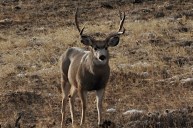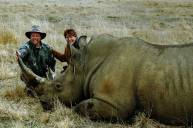Whether it be the beloved game animals that we hunt, or non-game, placing a radio collar on wild animals can give us an intimate look at their daily lives. In this way, we can begin to really understand how wildlife lives, eats, resides, and survives in ways our forefathers could have never dreamed possible. This kind of information helps everyone, especially the collared animals being studied.
Biologists and wild game managers have been at the forefront of capturing, tagging, tracking, and observing wild animals for many years and the techniques keep getting better and more sophisticated. Over the years, biologists have gathered some of the most important information about wildlife, especially when it comes to health, population, and disease control. And they're still learning.
How is it done? What is it like for the animals? Why is it normally radio collars? We'll try to answer most of these questions today and why this type of work is so vital in modern wildlife management.
A Short History of Game Animal Radio Telemetry
As hunters, we all track and anticipate game animal movement. Methods include watching their sign and listening for their sounds. But to truly track and learn from an animal's movement, consistency is key. The main way that's accomplished is through the use of radio tracking.
According to Frontiers in Ecology and Evolution, "The first radio-based animal tracking systems were developed in the 1950s and 1960s." This was done not only to tack these creatures, but to provide "biotelemetry data, for example related to activity, respiration, temperature, cardiovascular, gastroenterological, and neurophysiological function."
This same technology was applied in the 1960s and the 1970s, but when satellite systems made it onto the scene in the 1980s, remote radio collars were put into use. Without digging too deep into the technology, radio tracking collars are attached to an animal (usually one that's tranquilized or subdued to some extent) and send a signal providing the collar-wearer's whereabouts. It can be a steady signal, or sometimes is only sent once during a time period, like every hour or every four hours. No matter what the signal is, the data helps researchers to follow the movements of bighorn sheep, pronghorns, mountain goats, and a variety of other animal species in realtime.
Radio Collars as a Game Management Tool
The fact is, tracking these animals, even animals who we know migrate and where, is a vital tool in the health and conservation of their populations. From elk to whitetail deer and black bears to wolves, biologists have had access to tremendous amounts of information that concerns sportsmen and women everywhere.
Game animals can be marked and followed by radio transmission from many miles away to let them settle back into their territory and normal life, long after they have been set free from the capture-and-tag process. Now, biologists can determine if their mortality rates are due to difficulty in finding food, weather related, or even by predation or in some rare cases, poaching.
This is a great reason why predator species need to be watched as well.
Amongst the herding animals such as elk or even deer - particularly in the winter - it is imperative that these groups of animals be researched to ascertain whether or not they have been exposed to or are carriers of disease, such as chronic wasting disease or CWD.
Knowing where the animals are, have been, and are in the process of going helps to determine how wildlife biologists can identify problem areas faster. Disease assessment is now an integral part of understanding what is driving or limiting the population of a certain species in a certain area. They can also determine things like winter kill, and infant mortality rates which are vital to wildlife research.
Wildlife biologists also routinely share their finds within the community to help other scientists in comparing their information. This comes in extremely helpful where some game species can cross an international border at will.
Why Hunting Matters
The NC Wildlife Resources Commission, as on example, has recently partnered with NC State University on a program "called the Triangle Urban Deer Study, will explore many deer ecology factors, including deer mortality, deer abundance and human perceptions of deer."
Tracking urban and rural deer has a marked effect on the knowledge state wildlife agencies need to make the right choices when it comes to season dates and bag limits. Just because an animal is collared does not make it any more special though. In fact, the NCWRC has reminded us that (as with most deer hunting states) "Collared and tagged deer can be legally harvested during hunting seasons." It is an important part of any wild game study that game managers know when and where the deer were when they were harvested. Even with a harvested animal, scientists can gleam some valuable data that in turn helps guide the decisions of your state Department of Fish and Game. Plus, radio and GPS collars are expensive pieces of equipment, and it's likely the researchers will want those back from you.
It's not just large game animals either. Organizations like the NYSDEC, the Pennsylvania Game Commission, Ducks Unlimited, SUNY Brockport, and University of Saskatchewan have now partnered to study declining mallard population in parts of the Atlantic Flyway. Over 1,000 GPS transmitters on hen mallards will help biologists to learn more about habitat use, breeding success, and overall population health.
One of the spearheads of any study is the cooperation of the hunters who harvest these animals and report it to the scientists in charge. Think of radio collars as yet another tool of conservation. One that's highly more advanced, and one that provides more intimate data on animal's home range than scientists of the past could ever dream of gathering. If you ever harvest a tagged animal, make sure to let the researchers know. You'll be doing your part to aid in the preservation of the species!
Please check out my book "The Hunter's Way" from HarperCollins. Be sure to follow my webpage, or on Facebook and YouTube. Go to Rack Hub and use the coupon code Craiger for a new way to display those antler sheds!




